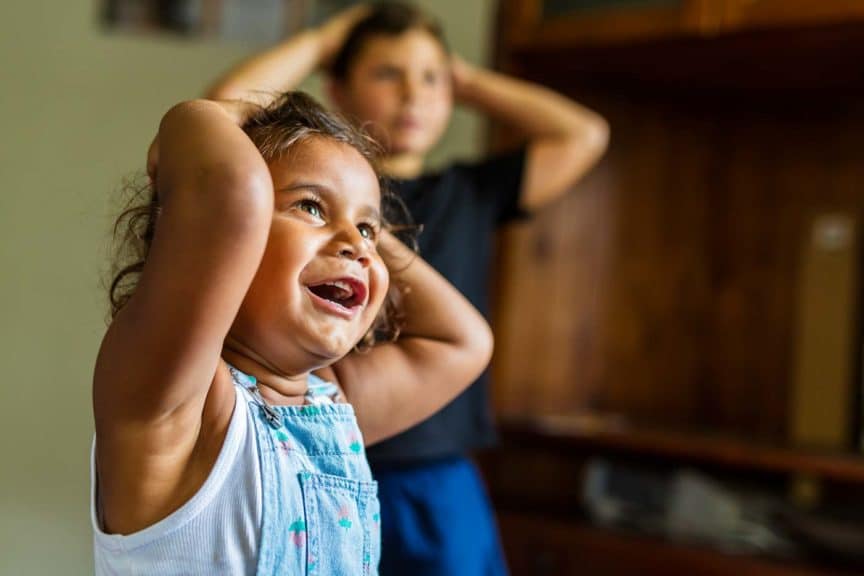Churches and children’s ministries come in all shapes and sizes.
The people on your team and the staff and volunteer positions in your ministry may look different from your colleagues in ministry, and that’s ok.
Your children’s ministry may have a dedicated, paid worship leader, but it’s more likely that you or a key volunteer fill that role.
Regardless of what that looks like in your church, you can lead kids to experience the presence of God during worship.
I’m a music girl through and through. I love singing and playing music—I write and even produce music. All of those things are important. And there’s nothing like leading people—especially kids—to worship God.

But I’m gonna be honest and pull back the curtain a bit on worship leading in kids’ ministries.
Behind the KidMin Worship Curtain
Whether I’m at a conference talking with a Kidmin leader or contributing to a conversation on a Facebook group, I often get asked questions like these:
- How do I lead worship when it’s not my forte?
- I can teach a Jesus lesson with no prep. But worship time? I feel like a fish out of water, and the kids can tell. So what can I do?
- We are smallish, so the teachers lead the worship time. And they’re not all gifted to lead worship… Is it okay for me to coach and train our worship leaders when I don’t know music?
I get it. I think this is a common issue in Kidmin. But my answer is “Yes!”
- Yes! You can lead worship even if you don’t know music.
- Yes! You can lead worship even if you can’t sing.
- Yes! You can train others to connect and engage a classroom during worship.
Here’s why.
The same qualities that make a great storyteller a great storyteller and that make one of your best teachers one of your best teachers, are some of the same characteristics of a great worship leader.
A great worship leader knows how to lead and engage their audience.
The Key to Leading Worship
The key to leading worship is to keep in mind you’re not just singing songs and filling time in a service. You are leading others and engaging them in a time of worship.
Above all, leading worship is a heart matter—it’s not a musical one.

Leading worship is a heart matter—it’s not a musical one.
I like to say it like this: Leading worship is more about your leadership ability than your musical ability.
But what I’m NOT saying is: Even if you know you can’t sing, you should project your voice into a microphone through a sound system to victimize everyone nearby. Ha!
If your voice makes people think of nails on a chalkboard or a howling cat (or wish they were hearing that instead), then, by all means, use the pre-recorded vocals. Don’t sing into a microphone.
Leading worship is more about your leadership ability than your musical ability.
But even if you shouldn’t use a microphone, you should:
- Model to others WHAT to do.
- Share with everyone HOW they can participate.
- Teach WHY a certain posture is needed at a certain time during worship.
- Lead a conversation about WHERE and WHEN we can worship God.
- SHOW what the joy of the Lord looks like in the life of a believer.
Experiencing God’s Presence
Leading a time of worship and navigating the journey from song to song and then to other segments in class enables kids to experience God’s presence and to actively participate in one of the core things they were created to do—praise their creator.
1 Peter 2:9 says: “But God chose you to be his people. You are royal priests. You are a holy nation. You are God’s special treasure. You are all these things so that you can give him praise. God brought you out of darkness into his wonderful light” (NIV).
Who we are in Christ goes hand-in-hand with the praise that we were made to give in return.
The essence of being a worship leader is not a musical thing. Of course, if you have musical giftings or awareness, that increases your ability in this area.
And it may even enhance how you coach others to lead.
Having musical talent isn’t a downside at all. But you don’t have to have the voice of Celine Dion to lead kids’ worship well.

For the sake of this conversation today, we’re gonna lay that requirement down. Go ahead—erase it. Or if you prefer, cross it out.
I hope many of you feel liberated—like a burden is lifted!
Even more so, I hope you understand and even believe that you can be a great kids’ worship leader—regardless of how well you sing.
And I hope you feel empowered to step on stage with more confidence than ever before.
Or you may need to encourage the others on your team. Maybe you’ve entrusted them with this role, and you need to encourage them to own it and really embrace leading kids in worship.
Worship Requires Participation
The songs you sing don’t just fill time in your service. They plant seeds that will get watered and nurtured again every time the person sings those words.
We all know songs from over the years that we can sing word for word right now even though we haven’t heard or thought about them in years.
That is a gift of music.
Consequently, the songs you sing will reinforce the message of your lesson and fills kids’ hearts and minds with Scripture and God’s truth.
So if you want to make the lessons you teach each week stick, choose songs that go hand in hand with those lessons. And choose songs that kids really like to sing.
Using music in our classrooms can accomplish a lot. Music can create energy, excitement, and engagement. It can help us feel and better grasp a concept we’re teaching.
Think of music as a tool, a piece of hardware, well-crafted equipment, a prop, or a vehicle for an experience or journey. I could go on and on, but you get the idea.
Embrace what worship can offer you and the kids you minister to.
For unique insights into worship issues and how to troubleshoot them in your ministry, check out 5 Surprising Solutions for Better Kids’ Worship.
Worship Is Not a Spectator Sport
Again, reflecting on my conversations with ministry leaders, I will hear them looking for a miracle drug. They want to just show music videos on a big screen with the expectation that all the kids in the room will magically start to worship.
When was the last time you watched a video on your phone, computer, or even a show on TV and hopped to your feet, started dancing, and broke into a time of worship for fifteen minutes?
I’m doubtful you could answer that question.
We aren’t wired to participate in what we watch. When we watch something, we just sit there as passive observers.

But the good news is that here are fabulous resources out there for kids’ worship!
WorshipHouseKids.com is a great place to get videos with the group viewing permissions you need.
Some of my favorites are by OrangeKidsMusic, Hillsong, and, of course, the KidminWorship.com series I do for preteen/elementary, and the LittlePraiseParty.com series I created for younger children.
But even the best songs and videos still need someone to lead them. That’s what a worship leader does.
A Worship Leader LEADS the Songs
When I spent time studying the Psalms and looking at David’s example, I realized that he showed us what to do and how to do it.
Your kids need that same type of instruction throughout your time of worship.
It’s not enough to say something before the first song and then never say anything else to coach them through the songs. We humans get easily distracted.
All it takes is for one kid to tap them on the shoulder to be a distraction.
Their stomachs begin to growl, and they start thinking about lunch.
Or maybe they’re going to a friend’s house after church and are super excited, so they start daydreaming about what all they’re gonna do later.
It could be as simple as a fly buzzing by and their eyes starting to follow it around the room.
There is a list of reasons a mile long for why your kids may suddenly stop participating during a song.
And 99 percent of them time they’re not intentionally thinking, “I will not take part in worship. No matter what they say, I’m not gonna sing.”
That really isn’t the heart of the majority of the kids you lead. They just need some guidance, understanding, and—most of all—reminders to get involved, be engaged, and take a step.
So, before the song begins, tell them about what they are to do or what the songs is about.
Psalm 66: 1-3 is a great reminder of why we worship: “Shout to God for joy, everyone on earth! Sing about the glory of his name! Give him glorious praise! Say to God, “What wonderful things you do! Your power is so great” (NIrV).
Give Instruction and Encouragement
Even if you’re using pre-recorded music, you can be the pilot and utilize the music in the arrangement of the song to lead your kids well with little nuggets of instruction.
During the instrumental sections of songs, you can insert instruction and encouragement.

Lead your kids by saying things like:
- Everybody, clap your hands!
- Let me hear you!
- Sing it louder!
- Don’t stop! Keep on singing!
- Everybody, sing!
- Lift your voice!
- Lift your hands and sing!
If there’s a really long piece of instrumental music within a song, encourage kids to interact with each other so they stay engaged in worship. Lead your kids by:
- Prompting them to tell three people, “God made you special.”
- Encouraging them to give each other high fives.
- Asking them to repeat a prayer.
Use the music to steer the ship where you want it to go. You need to control the track—don’t let the track control you.
Parts of a Song
For all of you non-music folk, here’s a little descriptive list of the various pieces of songs:
- Intro—any music at the beginning of the song before the singing starts.
- Verse—generally the first section of the song. There are usually at least two verses. The verse is less catchy and doesn’t have the hook of the chorus. Sometimes the verse words are the same—especially in kids’ songs—but in most adult songs the verses will have different lyrics.
- Chorus—the most sing-able, catchy part of the song. It’s the part that’s easiest to sing along with and tends to get stuck in your head.
- Turnaround—the time between a chorus and another verse.
- Instrumental—a music-only section that may happen before a bridge or that final chorus.
- Bridge—a third section of the song that normally ties the bow lyrically and musically speaking.
- Tag—the last line of a section that repeats.
- Outro—any music that’s at the end of the song after the singing portion has ended.
Keep inserting prompts throughout the songs and as you segue between the songs to remind everyone of the “what, why, where, and how” of worship.
They need you to remind them how to engage.
Think of the Trainer / Coach Model
Leading worship is a lot like being an aerobics instructor or personal trainer. But I don’t say that because of the motions and cardio that are often part of the kids’ worship!
Instead, I say it because sometimes we go to the gym on our own with the best of intentions, but when it gets a little hard and uncomfortable, we stop for a water break that turns into a rest break that turns into a run to the closest Starbucks. Right?
I’ve been guilty of this and maybe you have too.
Alternatively, maybe you played sports growing up and had coaches and trainers who worked with you.
Maybe you’ve taken workout classes where someone is leading the way, verbally encouraging you to keep on, work harder, and push farther than you’d be willing to go on your own.
That is your job as a worship leader: To coach others by pointing the way to go and encouraging them to not quit.
Help them take a new step and try something they haven’t before. Invite them to “do it again, sing it louder, raise their hands.” The list goes on and on.
Vocal Inflection Is an Accelerator
Remember that what makes a great storyteller or any great teacher in your classroom is their ability to really engage and get the attention of your children.
You want the kids to fully embrace and participate in what’s happening.
Inflection is an important tool to use when it comes to engaging kids with your words. You have to make sure you’re communicating what you’re trying to share with the right inflection.
If you’re super excited and passionate, you need to be louder and more excited than when you’re being vulnerable, sharing a hard lesson you’ve learned, or explaining the message of a song.

Your inflection needs to help communicate your message.
Let’s say you’re having the kids repeat something after you. Maybe it’s some of the words to the song you’re about to sing.
Line by line, get louder and bolder to build excitement. They will repeat it back to you with the same tone and style you use to project it to them.
There are times during songs when I have encouraged preschoolers to sing with each line getting louder and louder.
This works especially well when there’s a lot of repetition like in the worship chorus “God Is So Good”. In between the lines, I coach them to “sing it even louder”.
The same can work with getting softer and whispering.
Be Aware of Your Audience
Make eye contact. For the most part, it’s good to keep your eyes open. It seriously is so cool to realize the power that you have by simply locking eyes with a kid. I dare you to try it.
You can correct behavior simply by looking at them. And making eye contact can help kids feel known—you’ll notice a smile burst on their faces when they realize you see them.
As a worship leader, I do my best to stay aware of my audience. I’m constantly asking myself questions even at times adjusting what I’ve planned.
When I can see that a group of kids is not participating with me, I ask myself, “What can I do or say right now to try to engage them?”
If you need extra help getting the boys in your class to participate in worship, read this post on How to Engage Boys in Worship Without Embarrassing Them—it will help you be more strategic to include them!
You may rely on recorded vocals, but there’s no recording out there that can see your room—and, more importantly your kids—and be led by the Spirit of God.
Ask the Holy Spirit to guide what you say and do to help your kids press in and take a step in their worship of the Lord.
Believe in Yourself and Be Confident
Someone believes in you enough to entrust you with this responsibility and give you this opportunity.
Kids are the easiest group you’ll ever lead in worship. Trust me! They’re so much easier than a middle-aged man or middle schooler.
Many times, we get scared as if the kids are going to throw tomatoes at us when they don’t like our joke. Let’s be real—for the most part, kids are not going to bite or attack us. That fear is unlikely to ever become a reality.
So, guard against the seeds of fear and worry that would consume you and restrict you from leading kids to experience the presence of God during worship.
Someone gave you this task. Do the job to the very best of your ability. Walk in the freedom and confidence that only Jesus gives. Be an example and a leader of worship. On stage and off.
Believe in yourself and choose to step up and rock the worship leader role in your ministry.
I believe in you.
You can do this.

What if We’re Failing Kids at Faith Formation? (And How Not To)

What if We’re Failing Kids at Faith Formation? (And How Not To)











